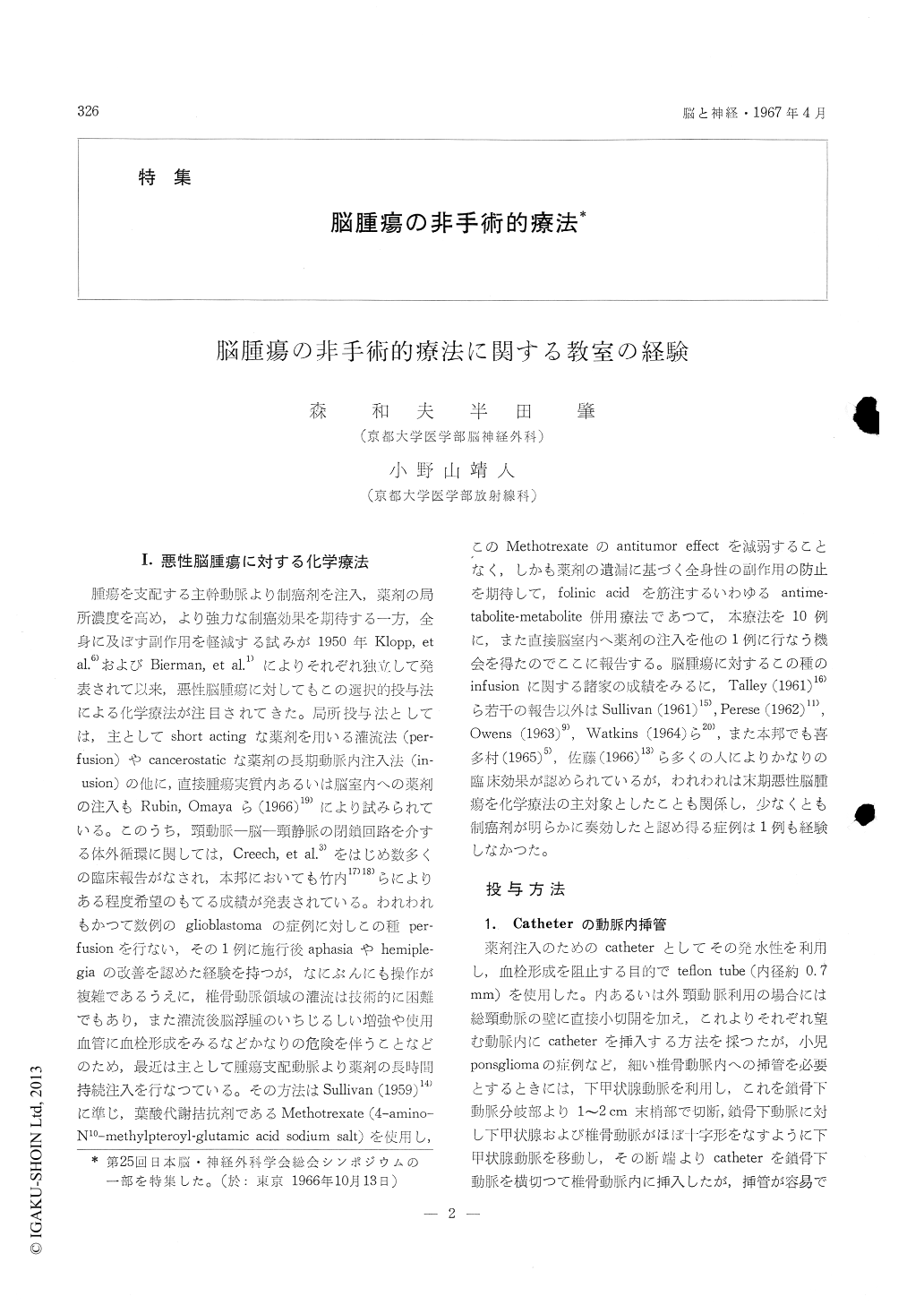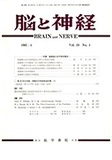Japanese
English
- 有料閲覧
- Abstract 文献概要
- 1ページ目 Look Inside
I.悪性脳腫瘍に対する化学療法
腫瘍を支配する主幹動脈より制癌剤を注入,薬剤の局所濃度を高め,より強力な制癌効果を期待する一方,全身に及ぼす副作用を軽減する試みが1950年Klopp, et al.6)およびBierman, et al.1)によりそれぞれ独立して発表されて以来,悪性脳腫瘍に対してもこの選択的投与法による化学療法が注目されてきた。局所投与法としては,主としてshort actingな薬剤を用いる灌流法(per—fusion)やcancerostaticな薬剤の長期動脈内注入法(in—usion)の他に,直接腫瘍実質内あるいは脳室内への薬剤の注入もRubin, Omayaら(1966)19)により試みられている。このうち,頸動脈—脳—頸静脈の閉鎖回路を介する体外循環に関しては,Creech, et al.3)をはじめ数多くの臨床報告がなされ,本邦においても竹内17)18)らによりある程度希望のもてる成績が発表されている。われわれもかって数例のglioblastomaの症例に対しこの種per—fusionを行ない,その1例に施行後aphasiaやhemiple—giaの改善を認めた経験を持つが,なにぶんにも操作が複雑であるうえに,椎骨動脈領域の灌流は技術的に困難でもあり,また灌流後脳浮腫のいちじるしい増強や使用血管に血栓形成をみるなどかなりの危険を伴うことなどのため,最近は主として腫瘍支配動脈より薬剤の長時間持続注入を行なつている。その方法はSullivan (1959)14,に準じ,葉酸代謝拮抗剤であるMethotrexate (4—amino—N10—methylpteroyl-glutamic acid sodium salt)を使用し,このMethotrexateのantitumor effectを減弱することなく,しかも薬剤の遺漏に基づく全身性の副作用の防止を期待して,folinic acidを筋注するいわゆるantime—tabolite-metabolite併用療法であつて,本療法を10例に,また直接脳室内へ薬剤の注入を他の1例に行なう機会を得たのでここに報告する。脳腫瘍に対するこの種のinfusionに関する諸家の成績をみるに,Talley (1961)16)ら若干の報告以外はSullivan (1961)15),Perese (1962)11),Owens (1963)9),Watkins (1964)ら20),また本邦でも喜多村(1965)5),佐藤(1966)13)ら多くの人によりかなりの臨床効果が認められているが,われわれは末期悪性脳腫瘍を化学療法の主対象としたことも関係し,少なくとも制癌剤が明らかに奏効したと認め得る症例は1例も経験しなかった。
I. Chemotherapy
Sullivan and associates (1959) reported new tech-nique of continuous, long-term arterial infusion of an antimetabolite to the patients with advanced can-cer in conjunction with the systemic administra-tion of its metabolite antagonist to prevent general toxicities and potential usefulness in this new meth-od has been reported by many authors.
In the past few years, we also tried intra-arterial regional infusion in 11 instances for the treatment of patients with advanced brain tumor (s). One of the drugs commonly used was methotrexate. FUdR and Nitrogen Mustard were also used for several cases.
Results were far more unsatisfactory. Seven cas-es out of these 11, died soon after chemotherapy without showing any noticeable improvement and definite palliation attributable to this therapy could not be obtained in any case. However, it is too early to evaluate the benefits of this kind of infusion therapy. Most of patients we treated were at or near the terminal stage and they developed severe systemic reactions despite ussage of the massive doses of antidote. Consequently, in most instances, it was unable to give full closes of anticancer agents. Better results might be expected if we treat patients at earlier stage and infusion can be continued for more prolonged period in the range of months rather than weeks.
II. Radiation Therapy
Results of 285 cases of brain tumors treated with radiation in our series of 1955-1964 were present-ed.
In the group of glioblastoma, results indicated that radiation following surgery may expect a mu-ch longer longevity.
In the cases of chromophobe adenoma, more re-markable improvement of visual function could be obtained in the group treated with surgery and subsequent irradiation as compared with that treat-ed with surgery alone. In view of this it would be incorrect to assume that radiation therapy alone is necessarily of equal effectiveness to combination therapy. Comparing the results obtained between the group treated with estimated tumor doses of more than and less than 6000R, more favorable results were noticed in the latter group.

Copyright © 1967, Igaku-Shoin Ltd. All rights reserved.


